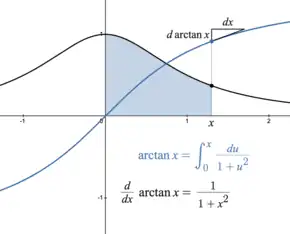In mathematics, Gregory's series for the inverse tangent function is its infinite Taylor series expansion at the origin:[1]
This series converges in the complex disk except for (where ).
It was first discovered in the 14th century by Madhava of Sangamagrama (c. 1340 – c. 1425), as credited by Madhava's Kerala school follower Jyeṣṭhadeva's Yuktibhāṣā (c. 1530). In recent literature it is sometimes called the Madhava–Gregory series to recognize Madhava's priority (see also Madhava series).[2] It was independently rediscovered by James Gregory in 1671 and by Gottfried Leibniz in 1673, who obtained the Leibniz formula for π as the special case[3]
Proof

If then The derivative is
Taking the reciprocal,
This sometimes is used as a definition of the arctangent:
The Maclaurin series for is a geometric series:
One can find the Maclaurin series for by naïvely integrating term-by-term:
While this turns out correctly, integrals and infinite sums cannot always be exchanged in this manner. To prove that the integral on the left converges to the sum on the right for real can instead be written as the finite sum,[4]
Again integrating both sides,
In the limit as the integral on the right above tends to zero when because
Therefore,
Convergence
The series for and converge within the complex disk , where both functions are holomorphic. They diverge for because when , there is a pole:
When the partial sums alternate between the values and never converging to the value
However, its term-by-term integral, the series for (barely) converges when because disagrees with its series only at the point so the difference in integrals can be made arbitrarily small by taking sufficiently many terms:
Because of its exceedingly slow convergence (it takes five billion terms to obtain 10 correct decimal digits), the Leibniz formula is not a very effective practical method for computing Finding ways to get around this slow convergence has been a subject of great mathematical interest.
History
The earliest person to whom the series can be attributed with confidence is Madhava of Sangamagrama (c. 1340 – c. 1425). The original reference (as with much of Madhava's work) is lost, but he is credited with the discovery by several of his successors in the Kerala school of astronomy and mathematics founded by him. Specific citations to the series for include Nilakantha Somayaji's Tantrasangraha (c. 1500),[5][6] Jyeṣṭhadeva's Yuktibhāṣā (c. 1530),[7] and the Yukti-dipika commentary by Sankara Variyar, where it is given in verses 2.206 – 2.209.[8]
See also
Notes
- ↑ Boyer, Carl B.; Merzbach, Uta C. (1989) [1968]. A History of Mathematics (2nd ed.). Wiley. pp. 428–429. ISBN 9780471097631.
- ↑ For example: Gupta 1973;Joseph, George Gheverghese (2011) [1st ed. 1991]. The Crest of the Peacock: Non-European Roots of Mathematics (3rd ed.). Princeton University Press. p. 428.Levrie, Paul (2011). "Lost and Found: An Unpublished ζ(2)-Proof". Mathematical Intelligencer. 33: 29–32. doi:10.1007/s00283-010-9179-y. S2CID 121133743.
- ↑ Roy 1990.
- ↑ Shirali, Shailesh A. (1997). "Nīlakaṇṭha, Euler and π". Resonance. 2 (5): 29–43. doi:10.1007/BF02838013. S2CID 121433151. Also see the erratum: Shirali, Shailesh A. (1997). "Addendum to 'Nīlakaṇṭha, Euler and π'". Resonance. 2 (11): 112. doi:10.1007/BF02862651.
- ↑ K.V. Sarma (ed.). "Tantrasamgraha with English translation" (PDF) (in Sanskrit and English). Translated by V.S. Narasimhan. Indian National Academy of Science. p. 48. Archived from the original (PDF) on 9 March 2012. Retrieved 17 January 2010.
- ↑ Tantrasamgraha, ed. K.V. Sarma, trans. V. S. Narasimhan in the Indian Journal of History of Science, issue starting Vol. 33, No. 1 of March 1998
- ↑ K. V. Sarma & S Hariharan (ed.). "A book on rationales in Indian Mathematics and Astronomy—An analytic appraisal" (PDF). Yuktibhāṣā of Jyeṣṭhadeva. Archived from the original (PDF) on 28 September 2006. Retrieved 2006-07-09.
- ↑ C.K. Raju (2007). Cultural Foundations of Mathematics : Nature of Mathematical Proof and the Transmission of the Calculus from India to Europe in the 16 c. CE. History of Science, Philosophy and Culture in Indian Civilisation. Vol. X Part 4. New Delhi: Centre for Studies in Civilisation. p. 231. ISBN 978-81-317-0871-2.
References
- Berggren, Lennart; Borwein, Jonathan; Borwein, Peter, eds. (2004). Pi: A Source Book (3rd ed.). Springer. doi:10.1007/978-1-4757-4217-6. ISBN 978-1-4419-1915-1.
- Gupta, Radha Charan (1973). "The Madhava–Gregory series". The Mathematics Education. 7: B67–B70.
- Horvath, Miklos (1983). "On the Leibnizian quadrature of the circle" (PDF). Annales Universitatis Scientiarum Budapestiensis (Sectio Computatorica). 4: 75–83.
- Roy, Ranjan (1990). "The Discovery of the Series Formula for π by Leibniz, Gregory and Nilakantha" (PDF). Mathematics Magazine. 63 (5): 291–306. doi:10.1080/0025570X.1990.11977541.